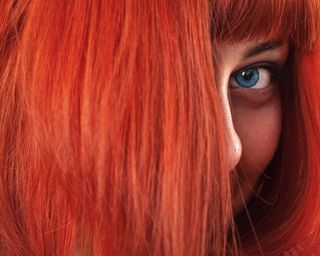Why Gray Hair Can Be a Good Thing

Would you rather have fiery red locks or hair of gray? For some animals, a grizzled look may be a sign of health, new research finds.
Wild boars with reddish coats have more cell damage than more mundanely colored wild pigs, Spanish researchers report in the July/August issue of the journal Physiological and Biochemical Zoology. The reason seems to be that the production of red pigment uses up an antioxidant that could otherwise be chasing down the free radicals that damage cells.
The findings could offer a tantalizing hint as to why red seems to be a costly color. In humans, studies have found that red hair and red pigments, or melanins, in skin are linked to higher rates of cancer.
"Given that all higher vertebrates, including humans, share the same types of melanins in skin, hair and plumage, these results increase our scant current knowledge on the physiological consequences of pigmentation," study researcher Ismael Galván of the Museo Nacional de Ciencias Naturales in Spain said in a statement.
There are two types of melanins, the pigments that lend hair and skin their color. Eumelanins are brown or black, while pheomelanins produce bright red or rich chestnut hues. Unlike eumelanin, pheomelanin requires a chemical called glutathione, or GSH, to produce the color.
GSH is an antioxidant, meaning it can halt the chemical reaction of oxidation. Oxidation reactions cause free radicals, which in turn cause cellular damage.
Galván and his colleagues wanted to know whether producing red hair would eat up GSH, leaving the body's cells more vulnerable to free radicals. They tested wild boars from southwestern Spain for oxidative stress, a measure of free radical damage.
Sign up for the Live Science daily newsletter now
Get the world’s most fascinating discoveries delivered straight to your inbox.
They found that the more pheomelanin a boar had in its fur, the more likely it was to have less GSH in the muscle cells and more oxidative stress.
"This suggests that certain colorations may have important consequences for wild boars," Galván said. "Pheomelanin responsible for chestnut colorations may make animals more susceptible to oxidative damage."
Meanwhile, gray hair, which results from an absence of melanin, seemed to be a mark of good health in wild boars.
"As with human hair, wild boars show hair graying all across their body fur," Galván said. "But we found that boars showing hair graying were actually those in prime condition and with the lowest levels of oxidative damage. Far from being a sign of age-related decline, hair graying seems to indicate good condition in wild boars."
In contrast, other experiments have suggested that gray hair in other animals is caused by cellular stress. Damage to pigment-producing cells called melanocytes may explain why our roots turn gray with age.
If pheomelanin has such a negative effect, the researchers aren't sure why it evolved in the first place. One hypothesis, Galván said, has to do with a chemical called cysteine. Cysteine is part of GSH and can be toxic in large quantities. Pheomelanin may have evolved to get rid of cysteine, with the loss of GSH as an unfortunate side effect.
Follow LiveScience on Twitter @livescience. We're also on Facebook & Google+.
Most Popular

